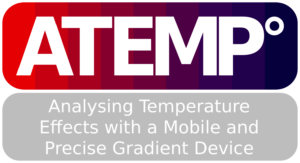The ATEMPGRAD device
The ATEMPGRAD device is a device designed for educational usage. It aims to allow teachers and students to undertake a variety of inexpensive and stable experiments in the subjects of physics, chemistry, biology, geography and mathematics. These experiments illustrate relationships in nature and thus make theoretical content more comprehensible by means of concrete, practical experiments.
The ATEMPGRAD device is a device with which temperature-dependent processes can be visualized. For this purpose, specimen are exposed to a temperature gradient for a certain time. Thus, temperature preferences of various living things can be determined or shown. In addition, there is a wealth of experiments on physical and chemical issues. Since data can be collected during these tests, it is possible to integrate the experiments in computer science / EDP teaching or to deal with mathematical or statistical questions.
For many obvious issues, such as aggregates, plant growth, or insect activity, temperature differences are relevant. But even with more complex issues, where it is less obvious to small, local temperature differences, such as evolution, climate change or industrial production processes, the device can be used purposefully. The complexity of the experiments and the increasingly difficult questions can be adapted to different age groups. Thus, the tool should be suitable for use in almost all school levels.
On a more technical side, the ATEMPGRAD device allows flexible creation of temperature patterns. Both linear gradients from cold to warm, as well as complex temperature environments can be set.
A prototype of this tool is already being used in university teaching, with a clearly focused field of application (insect ethology).
At this stage of the project, it is crucial to identify the needs of everyday school life and identify the needs of the educational device: What are the best educational opportunities? How much may such a device cost? And is there time and interest in such a tool in school lessons in Austria? On the basis of these findings, an optimized prototype should then be created, which can then already be used for test purposes in a school environment.
Do a few degrees temperature difference matter?
The device is designed to produce very shallow gradients and very subtle temperature differences are particularly relevant when talking about important processes of life.
Which living beings come into question?
These can be animal organisms such as insects and other arthropods, but also plant life or fungi and even certain microorganisms are suitable.
Which physical or chemical experiments are suitable for this?
Melting points of various substances, such as coconut oil or paraffin, can be determined, reaction rates, such as denaturing of proteins can be influenced.
How is the data collected?
Basically by direct observation, but it may be useful to take photos or videos.
How long do these experiment last?
From minutes to weeks. The melting point of coconut oil can be determined in a few minutes. It takes several days to determine the preferred germination temperature of certain plants. Crystallization experiments may take several weeks.







